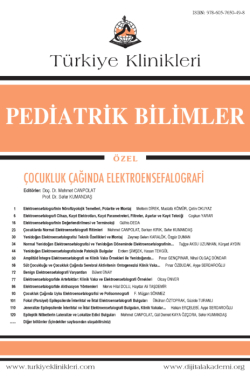Sleep Electroencephalography and Polysomnography in Childhood
F. Müjgan SÖNMEZa
aÇocuk Nörolojisi BD, Karadeniz Teknik Üniversitesi Tıp Fakültesi, Emekli Öğretim Üyesi, Trabzon, TÜRKİYE
Sönmez FM. Çocukluk çağında uyku elektroensefalografisi ve polisomnografi. Canpolat M, Kumandaş S, editörler. Çocukluk Çağında Elektroensefalografi. 1. Baskı. Ankara: Türkiye Klinikleri; 2019. p.93-100.
ABSTRACT
Polysomnography (PSG) is a diagnostic tool consists of a simultaneously measurement and recording of multiple physiological parameters. The most important endication for PSG in children is OSA and other sleep related breathing disorders. However, it is also used for the diagnosis of non-respiratory sleep disorders. PSG study is used some indications including diagnostic, assessment of an intervention (initiate and confirm the adecuacy a treatment) and follow-up of the children. PSG in children should be performed and interpreted in accordance with the recommendations of the AASM Manual for the Scoring of Sleep and Associated Events. In children, the clinical manifestations, diagnostic criteria and polysomnographic findings are likely to be different from adults.
Keywords: Sleep electroencephalography; polysomnography; childhood
Kaynak Göster
Referanslar
- Kryger MH, Roth T, Dement WC. Principles and practice of sleep medicine. 4th ed. Philadelphia, PA: Elsevier Saunder; 2005. p.957.
- Smith HR, Comella CL, Högl B. Sleep Medicine. Cambridge: Cambridge Universitiy Press; 2008. p.208-24. [Crossref]
- Galland BC, Taylor BJ, Elder DE, Hergison P. Normal sleep patterns in infants and children: a systematic review of observational studies. Sleep Med Rev. 2012;16(3):213-22. [Crossref] [PubMed]
- Kaynak H, Ardıç S. Uyku Fizyolojisi ve Hastalıkları. Türk Uyku Tıbbı Derneği Yayını. İstanbul: Nobet Matbaacılık; 2011. p.3-333.
- El Shakankiry HM. Sleep physiology and sleep disorders in childhood. Nat Sci Sleep. 2011;3:101-14. [Crossref] [PubMed] [PMC]
- Memar P, Faradji F. A novel multi-class EEGbased sleep stage classification system. IEEE Trans Neural Syst Rehabil Eng. 2018;26(1): 84-95. [Crossref] [PubMed]
- Berry RB, Brooks R, Gamaldo C, Harding SM, Lloyd RM, Quan SF, et al. AASM Scoring Manual Updates for 2017 (Version 2.4). J Clin Sleep Med. 2017;13(5):665-6. [Crossref] [PubMed] [PMC]
- Beck SE, Marcus CL. Pediatric polysomnography. Sleep Med Clin. 2009;4(3):393-406. [Crossref] [PubMed] [PMC]
- Aurora RN, Zak RS, Karippot A, Lamm CI, Morgenthaler TI, Aurbach SH, et al. Practice parameters for the respiratory indications for polysomnography in children. Sleep. 2011;34(3):379-88. [Crossref] [PubMed] [PMC]
- Pamula Y, Nixon GM, Edwards E, Teng A, Verginis N, Davey MJ, et al. Australiasian sleep association clinical practice guidelines for performing sleep studies in children. Sleep Med. 2017;36 Suppl 1:S23-42. [Crossref] [PubMed]
- Aurora RN, Lamm CI, Zak RS, Kristo DA, Bista SR, Rowley JA, et al. Practice parameters for the non-respiratory indications for polysomnography and multiple sleep latency testing for children. Sleep. 2012;35(11):1467-73. [Crossref] [PubMed] [PMC]
- Kotagal S, Nichols CD, Grigg-Damberger MM, Marcus CL, Witmans MB, Kirk VG, et al. Nonrespiratory indications for polysomnography and related procedures in children: an evidencebased review. Sleep. 2012;35(11):1451-66. [Crossref] [PubMed] [PMC]
- Roland PS, Rosenfeld RM, Brooks LJ, Friedman NR, Jones J, Kim TW, et al. Clinical practice guideline: polysomnography for sleep-disordered breathing prior to tonsillectomy in children. Otolaryngol Head Neck Surg. 2011;145(1 Suppl):S1-15. [Crossref] [PubMed]
- Tunkel DE. Polysomnography before tonsillectomy in children: who and when? Otolaryngol Head Neck Surg. 2011;146(2):191-3. [Crossref] [PubMed]
- Boss EF, Benke JR, Tunkel DE, Ishman SL, Bridges JF, Kim JM. Public insurance and timing of polysomnography and surgical care for children with sleep-disordered breathing. JAMA Otolaryngol Head Neck Surg. 2015;141(2):106-11. [Crossref] [PubMed]
- Horwood L, Brouillette RT, McGregor CD, Manoukian JJ, Constantin E. Testing for pediatric obstructive sleep apnea when health care resources are rationed. JAMA Otolaryngol Head Neck Surg. 2014;140(7):616-23. [Crossref] [PubMed]
- Goodwin JL, Enright PL, Kaemingk KL, Rosen GM, Morgan WJ, Fregosi RF, et al. Feasibilitiy of using unattended polysomnography in children for research--report of the Tucson Children's Assessment of Sleep Apnea Study (TuCASA). Sleep. 2001;24(8):937-44. [Crossref] [PubMed]
- Scholle S, Scholle HC, Kemper A, Glaser S, Rieger B, Kemper G, et al. First night in children and adolescents undergoing polysomnography for sleep-disordered breathing. Clin Neurophysiol. 2003;114(11):2138-45. [Crossref] [PubMed]
- Jacob SV, Morielli A, Mograss MA, Ducharme FM, Schloss MD, Brouillette RT. Home testing for pediatric obstructive sleep apnea syndrome secondary to adenotonsllar hypertrophy. Pediatr Pulmonol. 1995;20(4):241-52. [Crossref] [PubMed]
- Zaremba EK, Barkey ME, Mesa C, Sanniti K, Rosen CL. Making polysomnography more "child friendly:" a family-centered care approach. J Clin Sleep Med. 2005;1(2):189-98. [Crossref] [PubMed]
- Committee on Hospital Care and Child Life Council. Child life services. Pediatrics. 2014;133(5):e1471-8. [Crossref] [PubMed]
- Athiyaman K, Gowri Shankar M, Suji G, Prabhu D. A comparative study of adult and pediatric polysomnography. Int J Otorhinolaryngol Head Neck Surg. 2018;4(3):630-5. [Crossref]

